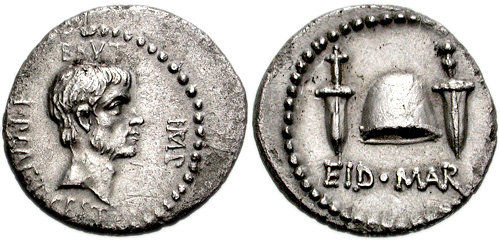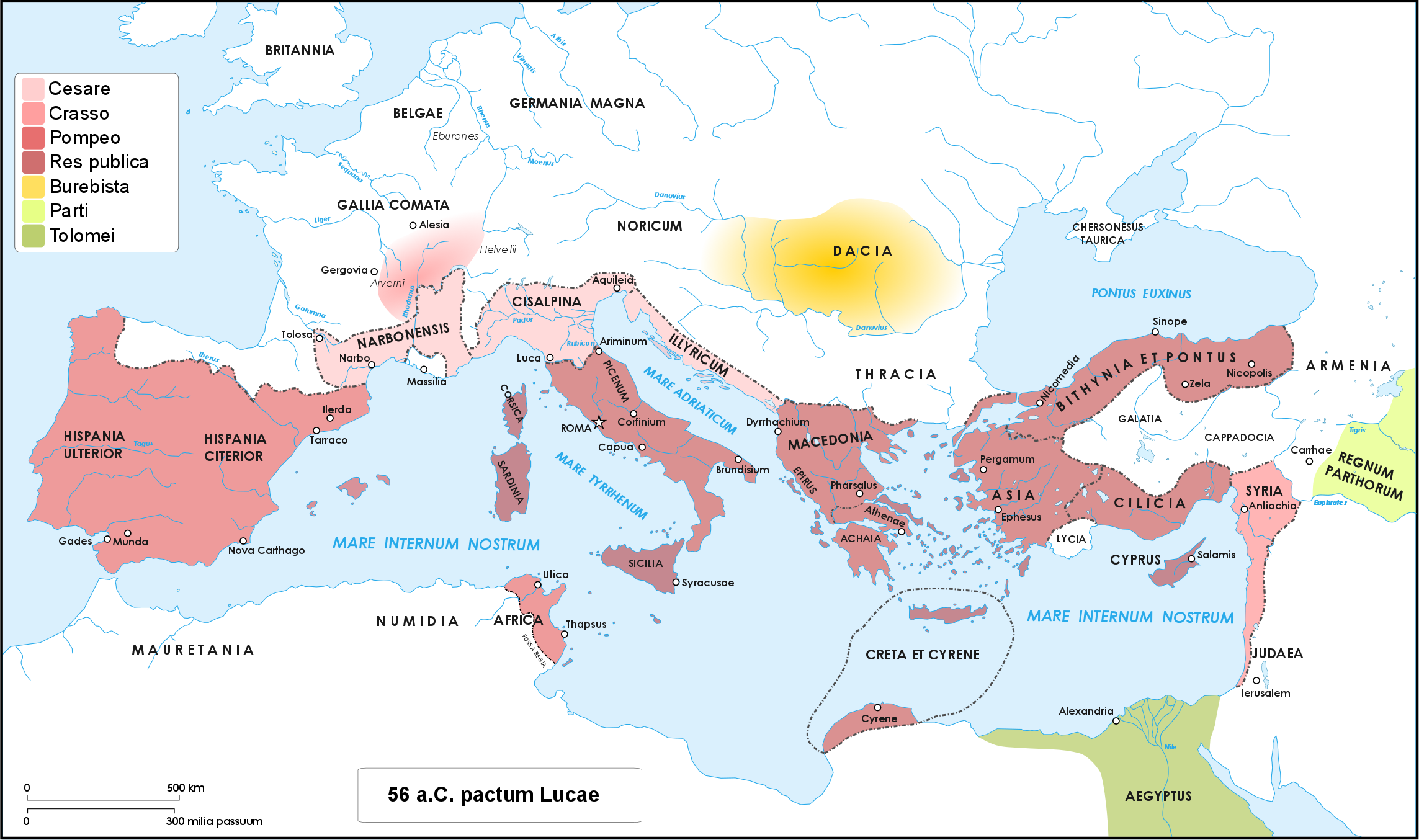|
Caesar's Assassination
Julius Caesar, the Roman dictator, was assassinated by a group of senators on the Ides of March (15 March) of 44 BC during a meeting of the Senate at the Curia of Pompey of the Theatre of Pompey in Rome where the senators stabbed Caesar 23 times. They claimed to be acting over fears that Caesar's unprecedented concentration of power during his dictatorship was undermining the Roman Republic. At least 60 senators were party to the conspiracy, led by Marcus Junius Brutus and Gaius Cassius Longinus. Despite the death of Caesar, the conspirators were unable to restore the institutions of the Republic. The ramifications of the assassination led to the Liberators' civil war and ultimately to the Principate period of the Roman Empire. Causes Caesar had served the Republic for eight years in the Gallic Wars, fully conquering the region of Gaul (roughly equivalent to modern-day France). After the Roman Senate demanded Caesar to disband his army and return home as a civilian, he ref ... [...More Info...] [...Related Items...] OR: [Wikipedia] [Google] [Baidu] |
Crisis Of The Roman Republic
The crisis of the Roman Republic refers to an extended period of political instability and social unrest from about 134 BC to 44 BC that culminated in the demise of the Roman Republic and the advent of the Roman Empire. The causes and attributes of the crisis changed throughout the decades, including the forms of slavery, brigandage, wars internal and external, overwhelming corruption, land reform, the invention of excruciating new punishments, the expansion of Roman citizenship, and even the changing composition of the Roman army. Modern scholars also disagree about the nature of the crisis. Traditionally, the expansion of citizenship (with all its rights, privileges, and duties) was looked upon negatively by Sallust, The History of the Decline and Fall of the Roman Empire, Gibbon, and others of their schools, because it caused internal dissension, disputes with Rome's Italian allies, slave revolts, and riots.Fields, p. 41, citing Sallust, ''Iugurthinum'' 86.2. However, other s ... [...More Info...] [...Related Items...] OR: [Wikipedia] [Google] [Baidu] |
Roman Republic
The Roman Republic ( la, Res publica Romana ) was a form of government of Rome and the era of the classical Roman civilization when it was run through public representation of the Roman people. Beginning with the overthrow of the Roman Kingdom (traditionally dated to 509 BC) and ending in 27 BC with the establishment of the Roman Empire, Rome's control rapidly expanded during this period—from the city's immediate surroundings to hegemony over the entire Mediterranean world. Roman society under the Republic was primarily a cultural mix of Latin and Etruscan societies, as well as of Sabine, Oscan, and Greek cultural elements, which is especially visible in the Roman Pantheon. Its political organization developed, at around the same time as direct democracy in Ancient Greece, with collective and annual magistracies, overseen by a senate. The top magistrates were the two consuls, who had an extensive range of executive, legislative, judicial, military, and religious powe ... [...More Info...] [...Related Items...] OR: [Wikipedia] [Google] [Baidu] |
Dictator Perpetuo
''Dictator perpetuo'' ( English: "dictator in perpetuity"), also called ''dictator in perpetuum'', was the office held by Julius Caesar from between 26 January and 15 February during the year 44 BCE until his death on 15 March. By abandoning the time restrictions usually applied in the case of the Roman dictatorship, it elevated Caesar's dictatorship into the monarchical sphere. History Julius Caesar held the dictator position for only eleven days in 49 BCE (holding elections either as ''dictator Comit. habend.'' or as ''dictator rei gerundae causa'') and again for the year 48/47 BCE. In 46 BCE, he was elected dictator for the next ten years. At some point between January and February 44 BCE he was appointed ''dictator perpetuo'', but was assassinated less than two months later (on the Ides of March). Weinstock has argued that the perpetual dictatorship was part of the senatorial decrees regarding Caesar's divine honors, as well as his planned apotheosis as ''Divus Iulius'' ... [...More Info...] [...Related Items...] OR: [Wikipedia] [Google] [Baidu] |
Caesar's Civil War
Caesar's civil war (49–45 BC) was one of the last politico-military conflicts of the Roman Republic before its reorganization into the Roman Empire. It began as a series of political and military confrontations between Gaius Julius Caesar and Gnaeus Pompeius Magnus. Before the war, Caesar had led an invasion of Gaul for almost ten years. A build-up of tensions starting in late 49 BC, with both Caesar and Pompey refusing to back down led, however, to the outbreak of civil war. Eventually, Pompey and his allies induced the Senate to demand Caesar give up his provinces and armies. Caesar refused and instead marched on Rome. The war was a four-year-long politico-military struggle, fought in Italy, Illyria, Greece, Egypt, Africa, and Hispania. Pompey defeated Caesar in 48 BC at the Battle of Dyrrhachium, but was himself defeated decisively at the Battle of Pharsalus. Many former Pompeians, including Marcus Junius Brutus and Cicero, surrendered after the battle, w ... [...More Info...] [...Related Items...] OR: [Wikipedia] [Google] [Baidu] |
Rubicon
The Rubicon ( la, Rubico; it, Rubicone ; rgn, Rubicôn ) is a shallow river in northeastern Italy, just north of Rimini. It was known as Fiumicino until 1933, when it was identified with the ancient river Rubicon, famously crossed by Julius Caesar in 49 BC. The river flows for around from the Apennine Mountains to the Adriatic Sea through the south of the Emilia-Romagna region, between the towns of Rimini and Cesena. History The Latin word comes from the adjective , meaning "red". The river was so named because its waters are colored red by iron deposits in the riverbed. During the Roman Republic, the Rubicon marked the boundary between the Roman province of Cisalpine Gaul and Italy proper, controlled directly by Rome and its (allies), to the south. On the north-western side, the border was marked by the river Arno, a much wider and more important waterway, which flows westward from the Apennine Mountains (the Arno and the Rubicon rise not far from each other) into the ... [...More Info...] [...Related Items...] OR: [Wikipedia] [Google] [Baidu] |
Roman Senate
The Roman Senate ( la, Senātus Rōmānus) was a governing and advisory assembly in ancient Rome. It was one of the most enduring institutions in Roman history, being established in the first days of the city of Rome (traditionally founded in 753 BC). It survived the overthrow of the Roman monarchy in 509 BC; the fall of the Roman Republic in the 1st century BC; the division of the Roman Empire in AD 395; and the fall of the Western Roman Empire in 476; Justinian's attempted reconquest of the west in the 6th century, and lasted well into the Eastern Roman Empire's history. During the days of the Roman Kingdom, most of the time the Senate was little more than an advisory council to the king, but it also elected new Roman kings. The last king of Rome, Lucius Tarquinius Superbus, was overthrown following a coup d'état led by Lucius Junius Brutus, who founded the Roman Republic. During the early Republic, the Senate was politically weak, while the various executive magistr ... [...More Info...] [...Related Items...] OR: [Wikipedia] [Google] [Baidu] |
France
France (), officially the French Republic ( ), is a country primarily located in Western Europe. It also comprises of overseas regions and territories in the Americas and the Atlantic, Pacific and Indian Oceans. Its metropolitan area extends from the Rhine to the Atlantic Ocean and from the Mediterranean Sea to the English Channel and the North Sea; overseas territories include French Guiana in South America, Saint Pierre and Miquelon in the North Atlantic, the French West Indies, and many islands in Oceania and the Indian Ocean. Due to its several coastal territories, France has the largest exclusive economic zone in the world. France borders Belgium, Luxembourg, Germany, Switzerland, Monaco, Italy, Andorra, and Spain in continental Europe, as well as the Netherlands, Suriname, and Brazil in the Americas via its overseas territories in French Guiana and Saint Martin. Its eighteen integral regions (five of which are overseas) span a combined area of ... [...More Info...] [...Related Items...] OR: [Wikipedia] [Google] [Baidu] |
Gaul
Gaul ( la, Gallia) was a region of Western Europe first described by the Romans. It was inhabited by Celtic and Aquitani tribes, encompassing present-day France, Belgium, Luxembourg, most of Switzerland, parts of Northern Italy (only during Republican era, Cisalpina was annexed in 42 BC to Roman Italy), and Germany west of the Rhine. It covered an area of . According to Julius Caesar, Gaul was divided into three parts: Gallia Celtica, Belgica, and Aquitania. Archaeologically, the Gauls were bearers of the La Tène culture, which extended across all of Gaul, as well as east to Raetia, Noricum, Pannonia, and southwestern Germania during the 5th to 1st centuries BC. During the 2nd and 1st centuries BC, Gaul fell under Roman rule: Gallia Cisalpina was conquered in 204 BC and Gallia Narbonensis in 123 BC. Gaul was invaded after 120 BC by the Cimbri and the Teutons, who were in turn defeated by the Romans by 103 BC. Julius Caesar finally subdued the remaining p ... [...More Info...] [...Related Items...] OR: [Wikipedia] [Google] [Baidu] |
Gallic Wars
The Gallic Wars were waged between 58 and 50 BC by the Roman general Julius Caesar against the peoples of Gaul (present-day France, Belgium, Germany and Switzerland). Gallic, Germanic, and British tribes fought to defend their homelands against an aggressive Roman campaign. The Wars culminated in the decisive Battle of Alesia in 52 BC, in which a complete Roman victory resulted in the expansion of the Roman Republic over the whole of Gaul. Though the Gallic military was as strong as the Romans, the Gallic tribes' internal divisions eased victory for Caesar. Gallic chieftain Vercingetorix's attempt to unite the Gauls under a single banner came too late. Caesar portrayed the invasion as being a preemptive and defensive action, but historians agree that he fought the Wars primarily to boost his political career and to pay off his debts. Still, Gaul was of significant military importance to the Romans. Native tribes in the region, both Gallic and Germanic, had att ... [...More Info...] [...Related Items...] OR: [Wikipedia] [Google] [Baidu] |
Gaius Iulius Caesar (Vatican Museum)
Gaius Julius Caesar (; ; 12 July 100 BC – 15 March 44 BC), was a Roman general and statesman. A member of the First Triumvirate, Caesar led the Roman armies in the Gallic Wars before defeating his political rival Pompey in a civil war, and subsequently became dictator from 49 BC until his assassination in 44 BC. He played a critical role in the events that led to the demise of the Roman Republic and the rise of the Roman Empire. In 60 BC, Caesar, Crassus and Pompey formed the First Triumvirate, an informal political alliance that dominated Roman politics for several years. Their attempts to amass power as were opposed by the within the Roman Senate, among them Cato the Younger with the frequent support of Cicero. Caesar rose to become one of the most powerful politicians in the Roman Republic through a string of military victories in the Gallic Wars, completed by 51 BC, which greatly extended Roman territory. During this time he both invaded Britain and built ... [...More Info...] [...Related Items...] OR: [Wikipedia] [Google] [Baidu] |
Roman Empire
The Roman Empire ( la, Imperium Romanum ; grc-gre, Βασιλεία τῶν Ῥωμαίων, Basileía tôn Rhōmaíōn) was the post- Republican period of ancient Rome. As a polity, it included large territorial holdings around the Mediterranean Sea in Europe, North Africa, and Western Asia, and was ruled by emperors. From the accession of Caesar Augustus as the first Roman emperor to the military anarchy of the 3rd century, it was a Principate with Italia as the metropole of its provinces and the city of Rome as its sole capital. The Empire was later ruled by multiple emperors who shared control over the Western Roman Empire and the Eastern Roman Empire. The city of Rome remained the nominal capital of both parts until AD 476 when the imperial insignia were sent to Constantinople following the capture of the Western capital of Ravenna by the Germanic barbarians. The adoption of Christianity as the state church of the Roman Empire in AD 380 and the fall of th ... [...More Info...] [...Related Items...] OR: [Wikipedia] [Google] [Baidu] |







